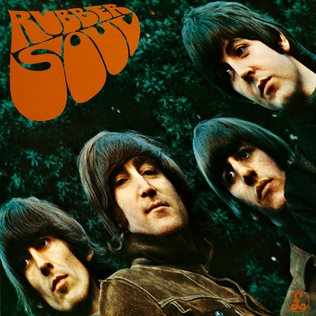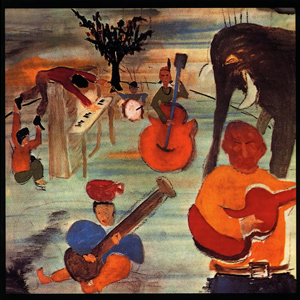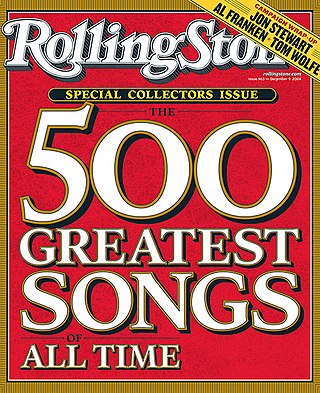
A concept album is an album whose tracks hold a larger purpose or meaning collectively than they do individually. This is typically achieved through a single central narrative or theme, which can be instrumental, compositional, or lyrical. Sometimes the term is applied to albums considered to be of "uniform excellence" rather than an LP with an explicit musical or lyrical motif. There is no consensus among music critics as to the specific criteria for what a "concept album" is.
Art rock is a subgenre of rock music that generally reflects a challenging or avant-garde approach to rock, or which makes use of modernist, experimental, or unconventional elements. Art rock aspires to elevate rock from entertainment to an artistic statement, opting for a more experimental and conceptual outlook on music. Influences may be drawn from genres such as experimental music, avant-garde music, classical music, and jazz.
Progressive rock is a broad genre of rock music that primarily developed in the United Kingdom and United States through the mid- to late 1960s, peaking in the early 1970s. Initially termed "progressive pop", the style was an outgrowth of psychedelic bands who abandoned standard pop traditions in favour of instrumentation and compositional techniques more frequently associated with jazz, folk, or classical music. Additional elements contributed to its "progressive" label: lyrics were more poetic, technology was harnessed for new sounds, music approached the condition of "art", and the studio, rather than the stage, became the focus of musical activity, which often involved creating music for listening rather than dancing.

Sgt. Pepper's Lonely Hearts Club Band is the eighth studio album by the English rock band the Beatles. Released on 26 May 1967, Sgt. Pepper is regarded by musicologists as an early concept album that advanced the roles of sound composition, extended form, psychedelic imagery, record sleeves, and the producer in popular music. The album had an immediate cross-generational impact and was associated with numerous touchstones of the era's youth culture, such as fashion, drugs, mysticism, and a sense of optimism and empowerment. Critics lauded the album for its innovations in songwriting, production and graphic design, for bridging a cultural divide between popular music and high art, and for reflecting the interests of contemporary youth and the counterculture.

Rubber Soul is the sixth studio album by the English rock band the Beatles. It was released on 3 December 1965 in the United Kingdom, on EMI's Parlophone label, accompanied by the non-album double A-side single "Day Tripper" / "We Can Work It Out". The original North American release, issued by Capitol Records, contains ten of the fourteen songs and two tracks withheld from the band's Help! album. Rubber Soul was met with a highly favourable critical response and topped sales charts in Britain and the United States for several weeks.

James Roger McGuinn is an American musician. He is best known for being the frontman and leader of the Byrds. He was inducted into the Rock and Roll Hall of Fame for his work with the Byrds. As a solo artist he has released 10 albums and collaborated with, among others, Bob Dylan, Tom Petty and Chris Hillman. The 12-string Rickenbacker guitar is his signature instrument.
Folk rock is a hybrid music genre that combines the elements of folk and rock music, which arose in the United States, Canada, and the United Kingdom in the mid-1960s. In the U.S., folk rock emerged from the folk music revival. Performers such as Bob Dylan and the Byrds—several of whose members had earlier played in folk ensembles—attempted to blend the sounds of rock with their pre-existing folk repertoire, adopting the use of electric instrumentation and drums in a way previously discouraged in the U.S. folk community. The term "folk rock" was initially used in the U.S. music press in June 1965 to describe the Byrds' music.

The English rock band the Beatles are commonly regarded as the foremost and most influential band in popular music history. With a line-up comprising John Lennon, Paul McCartney, George Harrison and Ringo Starr, they sparked the "Beatlemania" phenomenon in 1963, gained international superstardom in 1964, and remained active until their break-up in 1970. Over the latter half of the decade, they were often viewed as orchestrators of society's developments. Their recognition concerns their effect on the era's youth and counterculture, British identity, popular music's evolution into an art form, and their unprecedented following.

Music from Big Pink is the debut studio album by the Band. Released in 1968, it employs a distinctive blend of country, rock, folk, classical, R&B, blues, and soul. The music was composed partly in "Big Pink", a house shared by bassist/singer Rick Danko, pianist/singer Richard Manuel and organist Garth Hudson in West Saugerties, New York. The album itself was recorded in studios in New York and Los Angeles in 1968, and followed the band's backing of Bob Dylan on his 1966 tour and time spent together in upstate New York recording material that was officially released in 1975 as The Basement Tapes, also with Dylan. The cover artwork is a painting by Dylan.
The 39th Annual Grammy Awards were held on February 26, 1997, at Madison Square Garden, New York City. They recognized accomplishments by musicians from the previous year. Babyface was the night's biggest winner, with 3 awards. Celine Dion, Toni Braxton, Sheryl Crow, and The Fugees won two awards. Celine Dion for "Best Pop Album" and "Album of the Year" and Toni Braxton for "Best Female R&B Vocal Performance" and "Best Female Pop Vocal Performance". The show was hosted by Ellen Degeneres who also performed the opening with Shawn Colvin, Bonnie Rait, and Chaka Khan.
"Mr. Tambourine Man" is a song written by Bob Dylan, released as the first track of the acoustic side of his March 1965 album Bringing It All Back Home. The song's popularity led to Dylan recording it live many times, and it has been included in multiple compilation albums. It has been translated into other languages and has been used or referenced in television shows, films, and books.

Mojo is a popular music magazine published monthly in the United Kingdom, initially by Emap, and since January 2008 by Bauer. Following the success of the magazine Q, publishers Emap were looking for a title that would cater for the burgeoning interest in classic rock music. The magazine was designed to appeal to the 30 to 45-plus age group, or the baby boomer generation. Mojo was first published on 15 October 1993. In keeping with its classic rock aesthetic, the first issue had Bob Dylan and John Lennon as its first cover stars. Noted for its in-depth coverage of both popular and cult acts, it acted as the inspiration for Blender and Uncut. Many noted music critics have written for it, including Charles Shaar Murray, Greil Marcus, Nick Kent, David Fricke, Jon Savage and Mick Wall. The launch editor of Mojo was Paul Du Noyer and his successors have included Mat Snow, Paul Trynka, Pat Gilbert and Phil Alexander. The current editor is John Mulvey.

Cafe Wha? is a music club at the corner of MacDougal Street and Minetta Lane in the Greenwich Village neighborhood of Manhattan, New York City. The club is important in the history of rock and folk music, having presented numerous musicians and comedians early on in their careers, including Bob Dylan, Jimi Hendrix, Bruce Springsteen, The Velvet Underground, Cat Mother & the All Night Newsboys, Kool & the Gang, Peter, Paul and Mary, Woody Allen, Lenny Bruce, Joan Rivers, Bill Cosby, and Richard Pryor.

"The 500 Greatest Songs of All Time" is a recurring survey compiled by the American magazine Rolling Stone. It is based on weighted votes from selected musicians, critics, and industry figures. The first list was published in December 2004 in a special issue of the magazine, issue number 963, a year after the magazine published its list of "The 500 Greatest Albums of All Time". In 2010, Rolling Stone published a revised edition, drawing on the original and a later survey of songs released up until the early 2000s.

1001 Albums You Must Hear Before You Die is a musical reference book first published in 2005 by Universe Publishing. Part of the 1001 Before You Die series, it compiles writings and information on albums chosen by a panel of music critics to be the most important, influential, and best in popular music between the 1950s and the 2010s. The book is edited by Robert Dimery, an English writer and editor who had previously worked for magazines such as Time Out and Vogue.
"The Bells of Rhymney" is a song by folk singer Pete Seeger, which consists of Seeger's own music accompanying words written by Welsh poet Idris Davies. Seeger first released a recording of the song on a live album in 1958, but it is the American folk rock band the Byrds' 1965 recording that is the best known version of the song.

Elijah Wald is an American folk blues guitarist and music historian. He is a 2002 Grammy Award winner for his liner notes to The Arhoolie Records 40th Anniversary Box: The Journey of Chris Strachwitz.

Critic's Choice: Top 200 Albums is a musical reference book compiled by American-British journalist and broadcaster Paul Gambaccini. It was first published in the United Kingdom by Omnibus Press in January 1978, and then by Quick Fox in the US. The book comprises an annotated and illustrated list of the best albums in popular music, as selected from top-ten lists provided by its 47 contributors. As a multi-contributor work seeking to critique rock and pop albums, Critic's Choice preceded The Rolling Stone Record Guide and the Greil Marcus-edited Stranded: Rock and Roll for a Desert Island, both published in 1979. It was followed by several other books that classified the best pop recordings.












